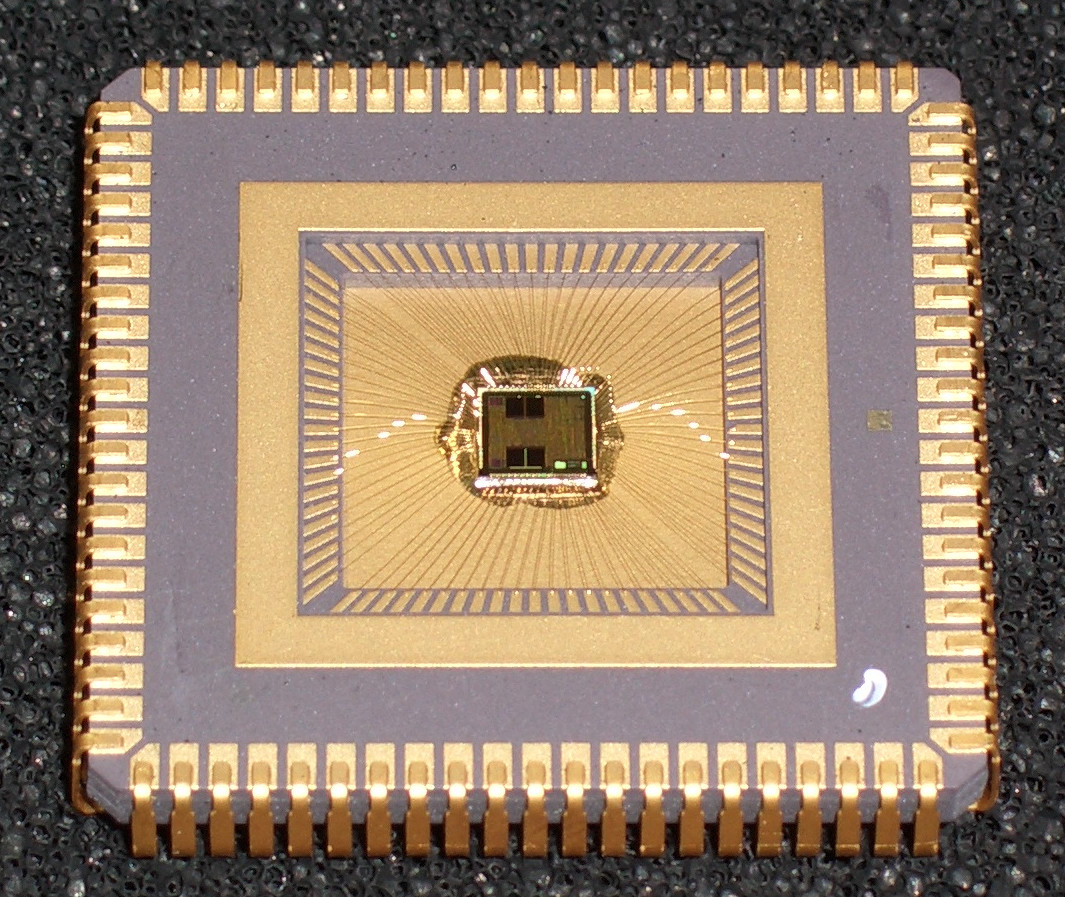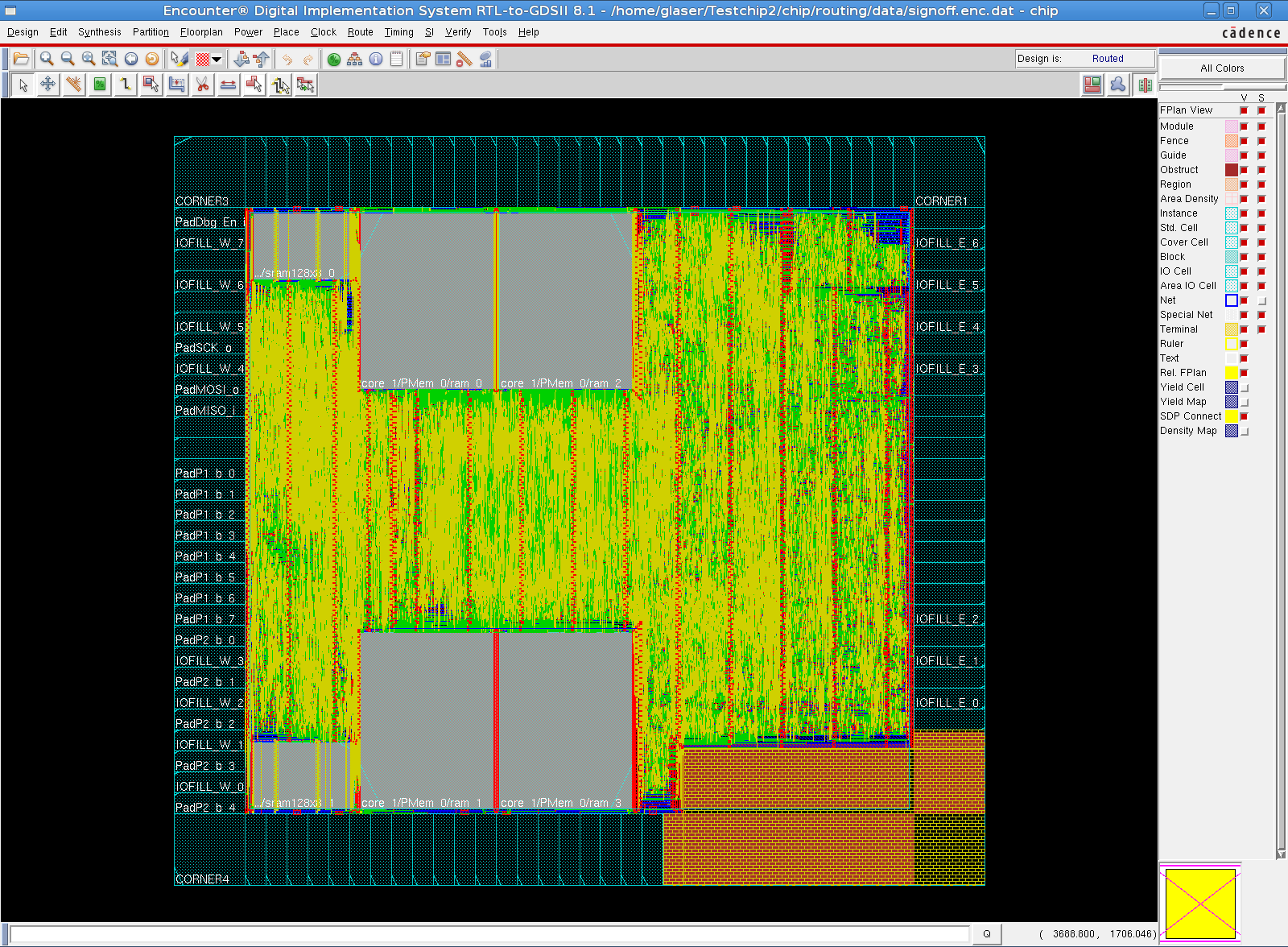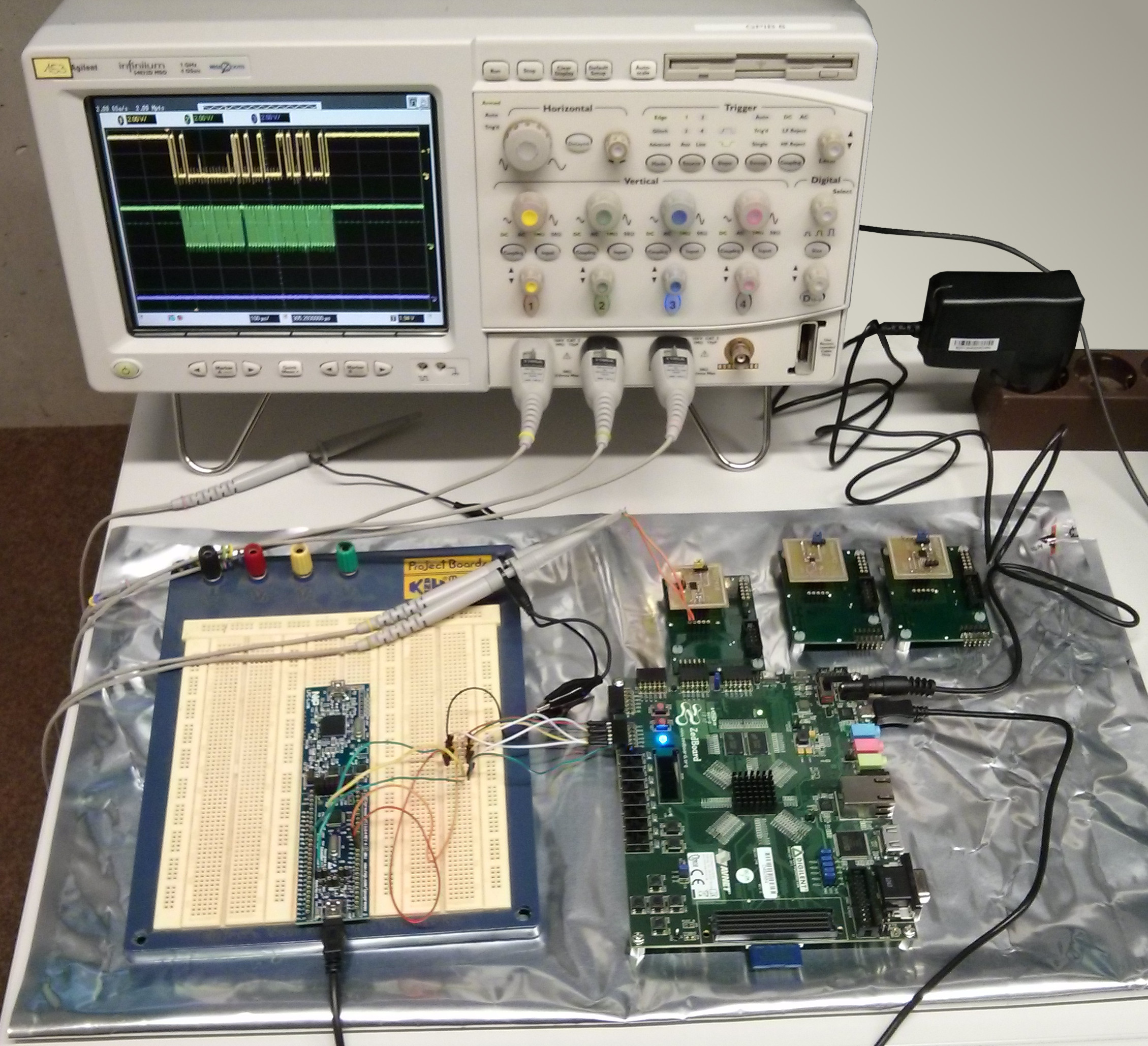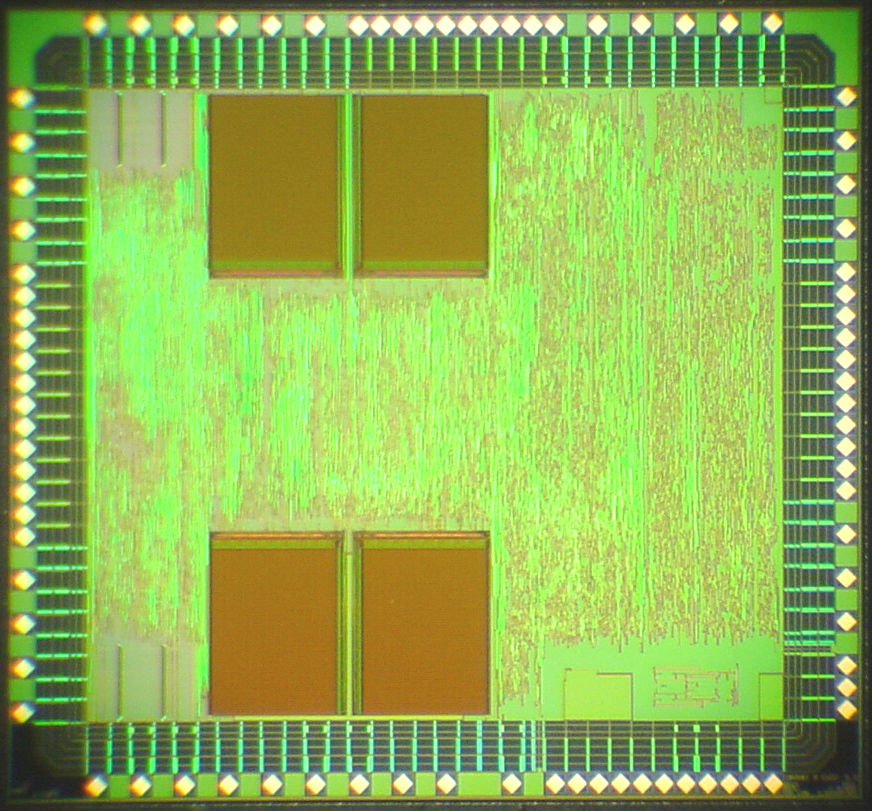Build your own custom FPGA and embed it in your ASIC or SoC. The reconfigurable logic architecture is semi-automatically generated and optimized to your application domain. You can also use this approach with commercial FPGAs, e.g., instead of partial reconfiguration.
If your target designs are similar and you do not need the tremendous flexibility of commercial (embedded) FPGAs, this project helps to reduce the power consumption, chip area, delay, and configuration data. Therefore the optimized reconfigurable logic architecture is not fine-grained as commercial 2D island-style FPGAs. Instead, it employs coarse-grained functional units tailored to your application domain.
The the reconfigurable architecture is generated as a soft IP core which consists of VHDL and Verilog designs. These are included in your ASIC or SoC. The generated designs adhere to the synthesizable hardware description language standards.
This project was developed as a PhD thesis [Gla15] at the TU Wien and verified by manufacturing an SoC. The scientific design methodology was implemented as an EDA design flow. The tools and the design of an exemplary SoC are included in this project.
README this file
doc/ documentation, see Sec. Documentation below
tools/
flowcmd/ FlowCmd, the command line interface
templates/ templates for scripts and logic designs
flowproc/ FlowProc, the central flow tool
trfsmgen/ TrfsmGen, to generate TR-FSM instances and configuration
yosys/ Yosys, a Verilog synthesis tool (external)
intersynth/ InterSynth, an interconnect generation tool (external)
yosys-plugin-stubnets/ a Yosys plugin to determine unused nets
common/ common source code used by multiple tools
depends/ experimental Makefile generator
examples/
wsn-soc/ the complete WSN SoC RTL design
Warning: The scripts in ./tools/depends/* are highly experimental,
untested, and were not used productively. They implement a bad solution for
dependency tracking. Please improve the scripts or implement a better
dependency handling approach.
Besides the tools provided in this project, the design flow also uses external tools.
- Yosys Open SYnthesis Suite
Yosys is a free framework for Verilog RTL synthesis by Clifford Wolf.
- InterSynth - Example-Driven Interconnect Synthesis
InterSynth is a tool by Clifford Wolf that generates (synthesizes) interconnects for heterogeneous coarse-grained reconfigurable logic circuits.
- EDA Tools
The design flow supports Mentor Graphics Questa Sim and ModelSim for simulation and Cadence Conformal LEC for logical equivalence checking.
For the ASIC or SoC implementation, industry standard tools like Synopsys Design Compiler are supported.
The WSN SoC includes the OpenMSP430 microcontroller core
http://opencores.org/project,openmsp430 using its SVN revision 191 at
./examples/wsn-soc/units/openmsp430/.
Modifications:
- removed
sync_cell_mclk_wkupinomsp_clock_module.v - adapted
openMSP430_defines.vto the requirements of the WSN SoC - added
omsp_clock_gate-dlsg1.vwith process specific standard cell - cherry picked a bug fix in the
omsp_uart.vfrom OpenMSP430 rev. 197 - use Verilog define HIER_MODULE instead of hard coded hierarchical signal
name in
msp_debug.v
The WSN SoC includes VHDL code of serial bus masters developed by students at
the TU Wien and supervised by the author of the design flow. The original
designs were slightly modified and placed in
./examples/wsn-soc/units/*_master/. Additionally, some testbenches use an
UART core located in ./examples/wsn-soc/vhdl_packs/units/core/tb/uart/.
- SPI Master and FIFO by Georg Blemenschitz
- I²C Master by Mario Faschang
- UART by Armin Faltinger
The initial design of the WSN SoC included more bus masters, but these were removed due to chip area constraints. In some source files there are commented references.
The documentation for this project is stored in ./doc/.
abstract.pdfand its sources in./doc/abstract/is a short introduction and motivation of this work and the PhD thesis.- TODO: PhD thesis [Gla15], especially Ch. 3, Ch. 4, and Sec. 5.1
- TODO: journal paper with a condensed introduction to the design methodology
- TODO: tutorial for the design flow
bibliography.bib: BibTeX file with the scientific publications of the author
- The design flow is operated from a Linux shell.
- GNU Make
- FreePascal compiler, version 2.6.4 was used
- TP Lex and TP Yacc as
plexandpyacc, which are included in the FreePascal utilities (e.g. Debian packagefp-utils-2.6.4). http://www.musikwissenschaft.uni-mainz.de/~ag/tply/ - The tool FlowCmd requires GNU Bash 4.0 or newer.
- The tools FlowProc and TrfsmGen were developed with the Lazarus IDE but this is not required to build.
pas-tclin./tools/common/pas-tcl/andpas-readlinein./tools/common/pas-readline/. Both projects are referenced using Git Submodules, see below.- GNU Readline development files
- Tcl development files
- Ronn to generate the man pages for FlowProc and TrfsmGen (e.g.,
https://rubygems.org/gems/ronn/, http://rtomayko.github.io/ronn/, or the
Debian package
ruby-ronn)
You can use FlowCmd from the location in the repository by executing it with
its complete path.
For a more comfortable usage copy (or link) the script, e.g., to
/usr/local/bin/.
In any case you have to edit the script and adjust the paths set as variables
TEMPLATEDIR, YOSYS, FLOWPROC, TRFSMGEN, and INTERSYNTH.
The projects pas-tcl and pas-readline are referenced using Git
Submodules. After cloning
this project, you have to add the submodules too.
git submodule init git submodule update
cd ./tools/flowproc/ make cd ../trfsmgen/ make
FlowProc and TrfsmGen were developed with the Lazarus IDE, therefore also .lpi
files are provided. However, the tools do not require any Lazarus specifics
(especially no GUI). The Makefiles directly use FreePascal to compile the tools, but
have lazbuild commented out if you like that better.
Both tools implement an interactive command line interface using GNU Readline
and Tcl. For each command a manual page is provided, however many commands are
not yet documented. The generation of the manual pages is implemented with
genman.sh of the pas-tcl project.
Download or clone Yosys from https://github.com/cliffordwolf/yosys and build as
explained in its README, e.g., in ./tools/yosys/.
There is also a Debian package yosys.
The WSN SoC was implemented using commit
3b52121d328d45a5d4269fd0e8de9af948c0216e.
Download or checkout InterSynth from http://svn.clifford.at/intersynth/trunk/
and build as explained in its README, e.g., in ./tools/intersynth/.
The WSN SoC was implemented using revision 62.
- Tools
- The tools FlowCmd, FlowProc, and TrfsmGen are distributed under the terms of the GNU GPL 2 or later. You can freely use these tools in the development of your (commercial) chip designs. If you improve the tools, you have to provide their source code, ideally by contacting the author, e.g., with a pull request. This however doesn't affect your chip design.
- Stubnets Yosys Plugin
- The Stubnets Yosys Plugin in ./tools/yosys-plugin-stubnets/ was developed by Clifford Wolf and improved by the author of the design flow. It is free and unencumbered software released into the public domain.
- FlowCmd Templates
- The FlowCmd templates for scripts and logic designs are distributed under the terms of the GNU LGPL 2 or later. You can freely use the design files and scripts in your (commercial) chip designs. If you improve the templates, you have to provide their source code. This however doesn't affect the other parts of your chip design and especially not the actual scripts used in the design which were derived from the templates.
- Turbo Pascal Lex/Yacc
- FlowProc and TrfsmGen use TP Lex and Yacc from
http://www.musikwissenschaft.uni-mainz.de/~ag/tply/ which are included in the
FreePascal utilities package. TP Lex and Yacc are licensed under the terms of
the GNU GPL 2 or later. Two files
./tools/flowproc/lexlib.pasandyacclib.pasare included in this repository. These were improved to support AnsiStrings, much larger parsing buffers, and show the filename, line, and column on errors. - Synopsys Liberty Parser
- FlowProc uses token.l and liberty_parser.y (translated to Pascal) of Synopsys "liberty_parse v 2.0". These are distributed under the terms of the Synopsys Open Source License Version 1.0.
- Yosys
- Yosys is an external tool: http://www.clifford.at/yosys/ Yosys is free software licensed under the ISC license (a GPL compatible license that is similar in terms to the MIT license or the 2-clause BSD license).
- InterSynth
- InterSynth is an external tool: http://www.clifford.at/intersynth/ InterSynth is free software licensed under the GNU GPL 2 or later.
- WSN SoC
- The WSN SoC is distributed under the terms of the GNU LGPL 2 or later. You can freely use the design files and scripts in your (commercial) chip designs. If you improve the design files or the scripts, you have to provide their source code. This however doesn't affect the other parts of your chip design.
- Serial Bus Masters included in the WSN SoC
- The serial bus masters for SPI and I2C protocols, the UART core as well as the commonly used FIFO are copyrighted by the respective authors.
- OpenMSP430 included in the WSN SoC
- The OpenMSP430 is licensed under the BSD license.
The design methodology for custom reconfigurable logic architectures and its implementation as an EDA design flow were demonstrated with the WSN SoC. This chip includes a reconfigurable module which implements an autonomous sensor interface. The chip was manufactured in a 350nm CMOS 4 metal layer process at AMS. For more details please see Ch. 4 and 5 of [Gla15] and the (forthcoming) tutorial.
This Github repository provides the complete RTL source code of the WSN SoC.
This includes the manually developed example applications
(./examples/wsn-soc/apps/) and cells (./examples/wsn-soc/celllib/) of
the reconfigurable module as well as all automatically generated files,
especially the reconfigurable module in
./examples/wsn-soc/units/reconfmodule/chll/out/reconflogic.vhd and
presilicon.v.
To test the WSN SoC design, it was implemented on a Xilinx Zynq FPGA (not using
its ARM CPUs) on the ZedBoard and connected to external sensors
(./examples/wsn-soc/units/core/zedboard/).
The WSN SoC design was synthesized with Synopsys Design Compiler to the AMS C35 standard cell library in the HIT-KIT 3.80 design kit. It also included two instances of a 128x8 SRAM and four instances of a 2kx8 SRAM for the OpenMSP430.
The layout was generated with Cadence Encounter. This was also used for parasitics extraction.
Static timing analysis was performed with Synopsys PrimeTime.
Synopsys Formality was used for logical equivalence checking to compare the netlists with the top level RTL design.
The gate level netlists with timing annotations were simulated with Mentor QuestaSim.
The gate level layout and netlist were imported to Cadence Virtuoso ICFB, which supplemented the detailed layout of all standard cells and SRAMs. Additionally the layout of a project of a colleague, logos, and process specific cells were added.
Special scripts for Mentor Calibre were used to generate metal fill structures.
The signoff verification (DRC, LVS) was also carried out with Mentor Calibre.
Screenshots of the WSN SoC design as well as photos of the chip are provided in
./examples/wsn-soc/doc/. The setup files and scripts for the tools mentioned
above (synthesis and so on) are not included in the repository due to licensing
conditions and non disclosure agreements.
The Transition Based Reconfigurable FSM (TR-FSM) is a reconfigurable architecture for FSMs. It is utilized in the generated reconfigurable architectures.
The TR-FSM design is available as VHDL design at
https://github.com/hansiglaser/trfsm. A copy is also included in this
project at ./examples/wsn-soc/celllib/trfsm/. The tool TrfsmGen at
./tools/trfsmgen/ generates customized instantiations of the TR-FSM and the
configuration data.
- install the design flow tools at central system directories, this also
requires the automatic adaption of links in
./tools/flowcmd/flow. - document all functions of FlowProc and TrfsmGen with individual man pages
- several VHDL modules (e.g., the serial bus masters) have Scan* ports which are unused and should be removed
- [Gla15]
- Johann Glaser. Design Methodology for Custom Reconfigurable Logic Architectures. PhD thesis, TU Wien, 2015. http://katalog.ub.tuwien.ac.at/AC12648292



